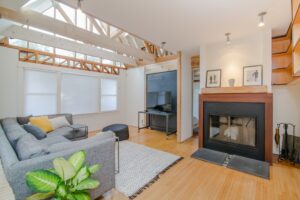The 1930s were an era of great change, with the introduction of new technologies and advancements in construction. However, with these changes came new problems for those living in homes from this era. Many of the houses built in the 1930s are still around today, but their age can lead to a variety of issues and challenges. This article will look at some of the most common problems with houses from the 1930s and provide advice on how you can address them.
Overview of 1930s Houses
One of the most significant issues with 1930s houses is their outdated electrical wiring. These homes were built before modern appliances became popular and therefore often lack sufficient capacity to handle the needs of today’s technology. Additionally, many 1930s houses have inadequate insulation, leading to energy loss and high utility bills.
Another common problem with 1930s homes is dampness and mold growth. These structures are typically constructed with solid walls that do not provide adequate ventilation, leading to excessive moisture buildup in the home. This can lead to mold growth, which can negatively impact indoor air quality and cause health problems for residents.
Lastly, asbestos is another issue commonly found in 1930s homes. Asbestos was a popular building material during this time period due to its heat-resistant properties but has been linked to lung cancer and other respiratory diseases. Therefore, it’s essential for homeowners to have their homes inspected for asbestos if they suspect their home may contain this hazardous material.
Foundation Issues
One of the most significant issues that homeowners with 1930s houses face is foundation problems. These types of homes were built with masonry block foundations, which can be prone to cracking and shifting over time. The primary cause of these issues is typically poor soil conditions or inadequate drainage around the foundation.
Some common signs of foundation problems in 1930s houses include cracks in the walls or floors, doors and windows that no longer close properly, and uneven flooring. In severe cases, homeowners may notice a visible slope in their floors or even experience difficulty opening and closing their doors due to a shifted foundation.
If you suspect your home has foundation issues, it’s essential to address them promptly by hiring a professional contractor who specializes in masonry repair. They will assess the extent of the damage and recommend an appropriate course of action to ensure your home remains safe and structurally sound for years to come.
Plumbing Problems
One of the most common plumbing problems that homeowners face in 1930s houses is outdated pipes. Many older homes have galvanized steel, copper or cast-iron pipes which are prone to corrosion and rusting. This can lead to issues such as leaks or water discoloration. Replacing these old pipes with newer materials like PVC or PEX can be an effective solution.
Another common issue is clogging in the sewer lines caused by tree roots. The trees planted around your house may have grown and extended their roots towards the sewer line, causing blockages that prevent waste water from flowing out of your home properly. A professional plumber can inspect the lines using a camera and remove any vegetation or debris causing blockages.
Finally, another issue seen in older homes is low water pressure due to corroded piping or buildup inside pipes over time. This can often be resolved by cleaning out the faucets, showerheads, and other fixtures that may become clogged with sediment buildup over time. Alternatively, it might be necessary to install a booster pump to increase water flow throughout your home if regular cleaning doesn’t help improve water pressure significantly enough on its own.
Electrical Wiring
One common problem with 1930s houses is outdated electrical wiring. Many of these homes still have knob-and-tube wiring, which was a popular method of electrical installation at the time but is now considered unsafe and inadequate for modern power needs. Knob-and-tube wiring lacks grounding, which can pose a fire hazard and increase the risk of electrocution.
Another issue with electrical wiring in 1930s houses is the use of aluminum wire instead of copper. While aluminum was cheaper than copper at the time, it has since been found to be less reliable due to its tendency to oxidize and corrode over time. This can result in loose connections, overheating, and potential fire hazards.
To address these issues, it is important for homeowners with 1930s houses to have their electrical systems inspected by a licensed electrician to ensure they are up-to-date and safe. Upgrading from knob-and-tube wiring to modern alternatives such as Romex or armored cable can improve safety and functionality while also increasing property value.
Structural Integrity
The structural integrity of 1930s houses has become a common problem among homeowners. These houses were built using traditional techniques and materials that have proven to be less durable over time. One of the most significant issues with these homes is their foundation. Many 1930s houses were constructed on shallow foundations that are prone to movement and cracks, particularly in areas prone to soil subsidence or changes.
Another issue with these homes is the roof structure. Most 1930s houses have flat roofs, which can pose drainage problems and lead to water damage if not adequately maintained. The use of single-skin walls in these properties also makes them vulnerable to dampness and mold growth, further compromising their structural integrity.
Restoring the structural integrity of a 1930s house requires careful planning and execution by qualified professionals who understand the unique construction methods used during this period. In some cases, it may require upgrading foundations or replacing roofing materials with modern ones that offer better protection against water damage. Homeowners looking to buy an older property should conduct a thorough inspection before making any purchase decisions to ensure they are getting value for their money and not inheriting costly structural issues down the line.
Heating and Cooling Challenges
One of the most common challenges faced by homeowners with 1930s houses is heating and cooling. These houses were built before central air conditioning and heat became standard features in homes, which makes it difficult to regulate the temperature. One common issue is poor insulation, which causes cold drafts in winter and hot spots during summer.
Another challenge is outdated HVAC systems that are not energy-efficient or effective at controlling temperature. This can lead to higher utility bills, as well as discomfort for residents. Additionally, some 1930s houses have unique architectural features such as high ceilings or narrow hallways that make it difficult to distribute warm or cool air evenly throughout the space.
Homeowners with 1930s houses face several heating and cooling challenges due to their outdated architecture and systems. However, there are solutions available such as installing modern HVAC systems, upgrading insulation, or utilizing window treatments to improve energy efficiency. By addressing these issues head-on, homeowners can ensure a comfortable living environment while also saving money on their energy bills.
Conclusion: Repairing 1930s Houses
In conclusion, repairing a 1930s house can be a challenging task. These houses are known for their unique architecture and charm, but they also come with some common problems that need to be addressed. One of the most common issues is the presence of lead paint, which can be harmful to human health. To solve this problem, homeowners should hire professionals who have experience in removing lead paint safely.
Another issue with 1930s houses is outdated electrical wiring. This poses a great risk of fire hazards and electrical shock to homeowners. It’s best to hire an electrician who understands how to work with old wiring systems while updating them with modern standards.
Lastly, 1930s homes tend to have inadequate insulation that leads to heat loss and high energy bills. The solution is to install energy-efficient windows and doors or adding extra insulation in the attic space or walls.
In short, repairing a 1930s house requires patience and attention as it involves addressing several problems specific to these types of properties. Taking care of these issues will ensure that you enjoy living in your charming abode without sacrificing safety or comfortability.


